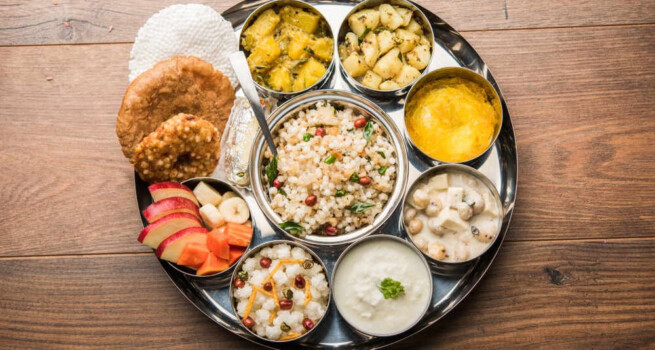
All our religious festivals usually hold logical and scientific explanations. They are invariably beneficial for your physical, mental and spiritual health. Navratri is not an exception. It is associated with the equinox, the time of the year when days and nights are of equal duration.
Equinoxes mark the transition period between two seasons. After an equinox, the duration of days and nights change. Therefore, during this time the body tries to adjust to the climatic and environmental changes and adapt to the new circadian rhythm. To achieve this purpose, fasts are observed.
Eating any wrong food during this time can adversely affect your immunity and create an imbalance in the body. Therefore, when it comes to Navratri fast, we have always been told to avoid specific foods or include certain foods.
However, have you ever thought about the reason behind it? What are the benefits you get from consuming these Navratri foods? Let’s find out.
WHAT FOODS ARE INCLUDED IN A NAVRATRI DIET?
Customarily, people who fast abstain themselves from eating certain foods like grains. Grains are full of nutrients and fibre, but they are also known to slow digestion. During detoxification, we must eat foods that are easy to digest and yet provide all the required nutrients.
Therefore, we tend to include pseudo-grains in our Navratri diet. Pseudo grains are not actually grains. They are usually flours obtained from seeds of broad-leaf plants. Some of the common pseudo-grains are Kuttu, Rajgira, Samak, etc.
5 MUST-INCLUDE FOODS AND RECIPES IN NAVRATRI DIET WITH THEIR BENEFITS
- Kuttu or Buckwheat
Kuttu is highly rich in dietary fibre and nutrients like protein, magnesium, vitamin B6, iron, vitamin B3, vitamin B1, phosphorus and zinc, making it ideal for a nutritious and fulfilling Navratri diet. Our favourite way of using kuttu is by making kuttu ka chilla.
How To Make Kuttu ka Chilla?
- Make a batter using kuttu ka atta, sendha namak, cumin seeds and green chillies. Make sure that the batter is of pouring consistency.
- Next, grease your skillet with desi ghee and pour a tablespoon of batter on it.
- Flip it and allow it to cook from both sides.
- Then, serve with chutney.
- Singhara or Water Chestnuts
Singhara is a fruit, and its flour is obtained after drying the fruit. Apart from having a cooling effect on the body, singhara also provides several nutrients like potassium, calcium, zinc, iron, phosphorus, magnesium, manganese and fibres. We love adding singhare ki kachori to our Navratri diet as it makes a fulfilling lunch.
How To Make Singhare Ki Kachori?
- Take singhara flour in a bowl and mash 2-3 boiled potatoes in it.
- Then add ginger, green chillies, coriander and sendha namak to the batter and knead it to form a soft dough. Do not add water to it.
- Next, add some desi ghee in a wok or kadhai.
- While the ghee is getting hot, grease your hands and make small balls from the dough. Flatten them to make pooris.
- Then, gently slide the flattened pooris into the oil and press them gently to make them puffy.
- Once fried from both sides, serve them with mint chutney or aloo ki sabzi.
- Samak Rice
An excellent source of phytochemicals, samak is loaded with calcium, potassium, phosphorus, vitamins and magnesium. Therefore, it is highly beneficial for detoxifying the body. We love including samak khichdi in our Navratri diet.
How To Make Samak Khichdi?
- Soak samak rice in a bowl for an hour, and then drain all the water and keep it aside.
- Next, add desi ghee, cumin seeds, ginger and green chillies in a pressure cooker and saute for a few minutes.
- Then add 1-2 chopped potatoes into the pressure cooker and saute it again for a few minutes on medium heat.
- Next, add samak rice and sendha namak to it and mix well.
- Add 2-3 cups of water, depending on the desired consistency of the khichdi.
- Cover the pressure cooker and allow it to cook.
- You can garnish it with ghee and coriander and eat it with curd or yoghurt.
- Sabudana or Sago
While fasting, your body needs good carbohydrates to keep functioning properly. This purpose is served by the carb-rich sabudana pearls. Apart from carbohydrates, sabudana also contains protein, vitamins and minerals.
There are many things you can make from sabudana, including sabudana khichdi, sabudana tikki, etc. Our favourite is mouthwatering sabudana tikki.
How To Make Sabudana Tikki?
- Rinse and soak sabudana pearls overnight or for at least 5-6 hours.
- Then, drain the water and keep sabudana aside.
- Next, mash a boiled potato and add green chillies, a few roasted peanuts, cumin powder, lime juice, sendha namak and soaked sabudana to it.
- Mix everything well and form small flat patties from it.
- Heat desi ghee in a skillet and add sabudana tikkis to it. Fry them from both sides till they turn golden brown in colour.
- Serve them hot with coriander chutney.
- Rajgira or Amaranth
Rajgira is well known for its protein content. However, it is also packed with dietary fibres, iron, magnesium, zinc, calcium and vitamins. One of the best ways to add rajgira to your Navratri diet is by making rajgira cutlets.
How To Make Rajgira Cutlets?
- Heat some desi ghee in a frying pan and add green chillies and ginger. Saute for a minute, and then add rajgira seeds or ramdana to it.
- Saute it again for a minute, and then add sendha namak and freshly-grounded black pepper.
- After roasting the mixture for a few minutes, add some water to it.
- Cover the lid and let it cook for a few minutes.
- Then, turn off the heat and transfer the mixture to a bowl.
- Add boiled and mashed potatoes, coriander leaves and roasted peanuts to the mixture.
- Knead the mixture to form a soft dough and then divide it into small balls.
- Flatten each ball to form cutlets and fry them in desi ghee till they turn golden brown.
- Serve hot with tamarind or mint chutney.

